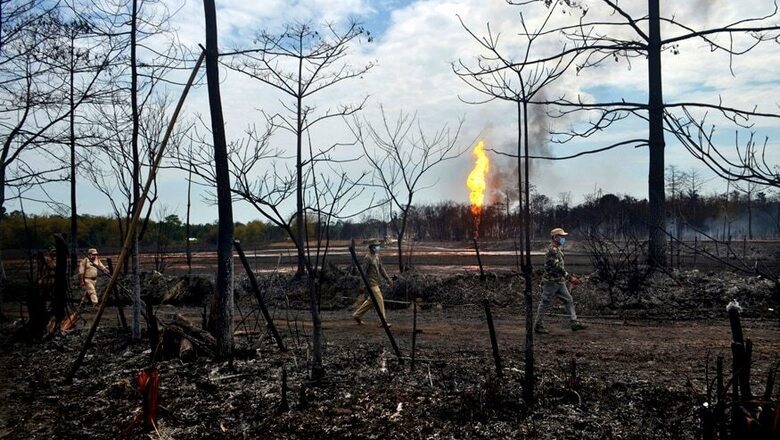As Assam's Baghjan Gas Well Fire Continues to Burn After 100 Days, Here's a Timeline of the Disaster

views
Uncertainty looms over the dousing of the Baghjan well fire as the only remaining hope now lies with the team of experts flying down from Canada to ‘kill the well’ with ‘snubbing’ technology. This process could take another 6-8 weeks, as told by Assam industry minister Chandramohan Patowary in the state assembly on Wednesday. Replying to a Zero Hour notice by the Congress’s Durga Bhumij, Patowary said, “Experts are on their way to Baghjan from Canada in a special aircraft with equipment to kill the well and it may take another 6-8 weeks to complete the operation.”
Notably, this is not the first time foreign experts are landing in Baghjan to douse the fire and a lot has happened since the blowout of May 27. Here’s a reminder:
1. An explosion was reported at Baghjan production well 5 under Baghjan Oil field of Oil India Limited in Tinsukia, Assam on the morning of May 27, 2020. Oil India suspended their operations as the well started releasing natural gas uncontrollably. Oil India issued a statement later stating that the blowout happened while work-over operations were going on to produce gas from a new oil and gas bearing reservoir and a crisis management team is trying its best to control the well. The company also claimed to be putting in efforts towards evacuating local residents from the vicinity of the well to safe areas.
2. The oil spill continued, adversely affecting the aquatic life of the river Dibru. On May 29, locals recovered a floating carcass of a Gangetic river dolphin, showing the devastating effect of the spillage. The huge threat deepened for the Maguri Motapung wetland, a known spot for avian and aquatic species based within a 1 km radius of the well, and Dibru Saikhowa national park, situated around 2 km in the north from the place
3. After 10 days of the blowout, a three-member team of experts from Singapore-based disaster management firm Alert Disaster Control reached Baghjan on June 8. The team comprised Michael Ernest Allcorn, Craig Neil Duncan and Edward Harris MacLeod.
4. While the Singapore expert team was doing its job to put an end to continuous leakage of gas and associated condensate, the well caught fire on June 9. Oil India informed the media that the well caught fire while the clearing operations were going on. The raging inferno could be seen from a 10 km distance, and within hours the fast-spreading fire engulfed many trees and households, affecting lives of more than 3,000 local residents. Angry with Oil India’s failure, some locals attacked the company’s vehicles and shouted slogans. At least 2,500 people were forced to take shelter in relief camps.
5. Bodies of two Oil India firefighters were recovered from a pond near the well on June 10, a day after they jumped into the water body while trying to escape the uncontrolled fire and went missing. The deceased were Durlav Gogoi, a former goalkeeper of Assam state football team and fellow Oil India firefighter Tikheswar Gohain. Two other firefighters, who also plunged into the pond, managed to escape unhurt.
6. Several mild tremors were felt in Baghjan and adjoining areas on June 11, leading to panic in upper Assam’s Tinsukia district. Meanwhile, fire tenders from the Indian Air Force and ONGC continued their efforts to douse the flames. The entire area was cordoned off by the Army to prevent any untoward actions caused by enraged residents.
7. Assam chief minister Sarbananda Sonowal ordered a high-level probe into the Baghjan incident on June 11. The government also sanctioned 50 lakh rupees for immediate relief to the displaced people. Oil India suspended two officials for alleged negligence of duty at the gas well site and a show-cause notice was sent to John Energy Pvt Limited, the outsourced private operator of the well. The company assured the Assam government that the fire would be doused within 21 days, i.e., by July 7.
8. Another three-member expert team from Canada and the United States reached Baghjan on June 13 to join the operation at the blowout site. The team comprised Mathew Connors from Canada, and Anthony Steven Reynolds and Dough Dallas from the USA.
9. Oil India later extended the deadline till July 11 and yet failed to douse the fire. The company claimed completion of 90 per cent of the work.
10. Suffering for more than a month, an agitated resident of Baghjan village, 45-year-old Sukleswar Neog, committed suicide by consuming poison on July 18. This intensified the ongoing protests by the people of Baghjan.
11. The efforts to plug the blowout suffered a setback as three foreign experts, Anthony Steven Reynolds, Dough Dallas and Craig Neil Duncan, sustained burn injuries while trying to control the blaze. Officials said the hired expert team of Oil India was removing a spool from the wellhead, a process carried out before installing a blowout preventer (BOP) to cap the fire and blowout.
12. The attempt to place the blowout preventer (BOP) failed on July 31 as the Athey wagon toppled while carrying it.
13. The national Green Tribunal rejected the objections raised by Oil India Ltd to a preliminary report filed by a committee on the Baghjan fire incident on August 8. Oil India raised doubts on the findings of the committee that made three categories of people entitled to interim compensation of 2.5 lakh, 10 lakh and 25 lakh rupees. The categories were based on the extent of damage caused by the fire.
14. The effort to plug the leak continued and on August 10, the team somehow placed the BOP successfully on the wellhead, but unfortunately one of the two bull lines (cables) of the Athey wagon, a 90-foot-long vehicle used to lift the BOP, snapped. The extreme weight and intense heat caused a technical snag leading to another failed attempt of capping the well.
15. After several failed attempts of plugging the leak, Oil India Limited announced on September 1 that they are planning to ‘partially produce’ natural gas from the well once again. According to the plan suggested, a large portion of the natural gas coming out from the well will be transferred to a nearby reproduction setup and the rest of the gas will be flared.
16. As all the traditional methods of capping the well proved futile, the Assam government finally made an announcement on September 2 about ‘killing the well’ with support of the expert team of Canada. This process might take another 6-8 weeks, said minister Chandramohan Patowary on Wednesday.
17. Agitated residents continued their protest for the 10th consecutive day in front of the Tinsukia district collector’s office on Thursday. They asked for proper compensation from the government and set a deadline of four days to meet their demand.
















Comments
0 comment